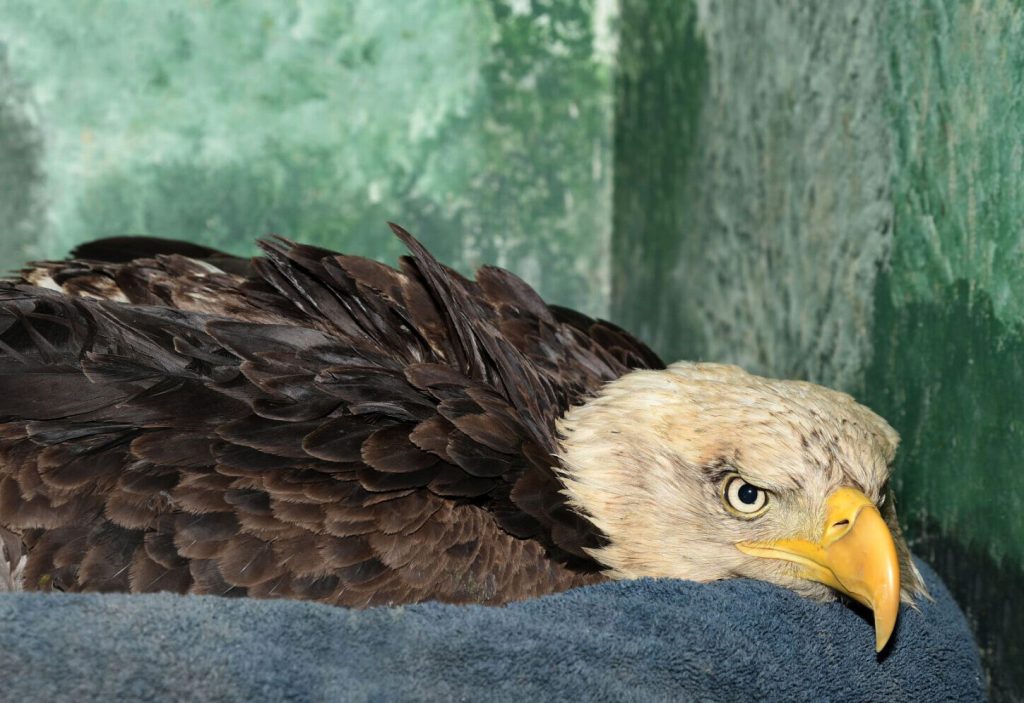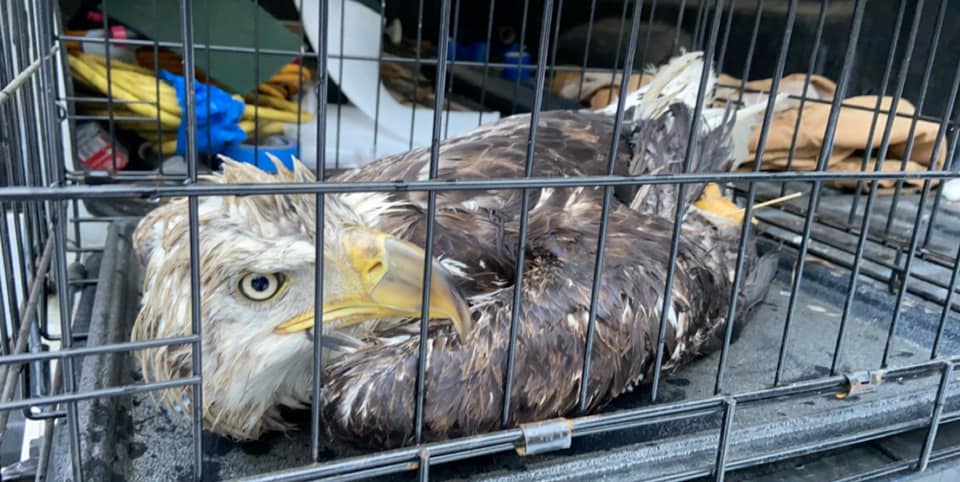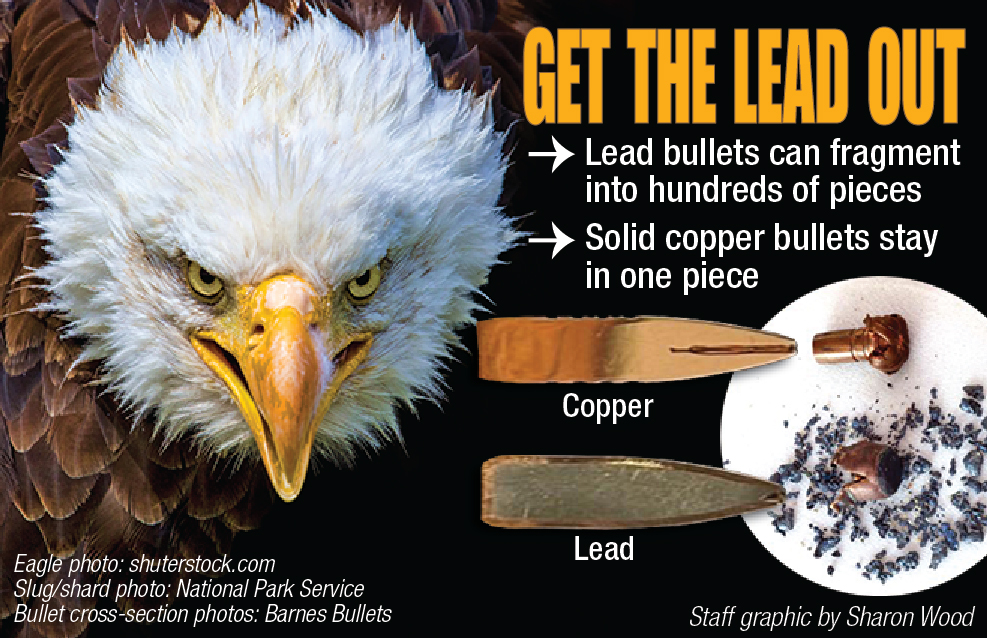Five bald eagles have died at a rescue organization in Freedom since the beginning of 2020, all with elevated levels of lead in their blood. The deaths have refreshed longstanding concerns about the use of lead ammunition, which is believed to be a root cause of the raptors’ sickness.
Still, “the bald eagle population is healthy and continues to grow and expand,” according to Erynn Call, the state’s raptor specialist with the Maine Department of Inland Fisheries & Wildlife.
The eagles were brought to Avian Haven, a wild bird rehabilitation center, between Jan. 2 and Jan. 14 from the Rome-Smithfield area, Thorndike, Sullivan, North Chester and Peru, according to the group’s Facebook page. Diane Winn, a co-founder of Avian Haven, said that while it is unusual for that many lead-affected eagles to be brought in during a two-week period, elevated blood lead levels are a common occurrence in the eagles they receive.
Since 2015, Avian Haven has logged 57 cases involving eagles with significantly elevated blood lead levels, averaging between 11 and 12 affected raptors a year, Winn said. Several contained such high levels of lead in their system that it was beyond the maximum value on the lead test kit, which is 65 micrograms per liter, according to the Department of Inland Fisheries & Wildlife.
Eagles become affected by lead primarily through ingesting fragments of lead bullets in the gut piles and abandoned carcasses of its prey, according to Call. Coyote bait containing lead fragments is another leading cause of exposure in Maine eagles, Winn and Call said. The issue is not unique to Maine and has been well-documented across the country.
“Lead is a soft, pliable metal and it fragments easily,” Call said. “When an animal is shot with a lead bullet, as much as a third of the bullet’s total weight is fragmented in hundreds of pieces in the animal. And that’s true even if the bullet passes through the entire animal and is independent of hunter skill and where on the body an animal is shot. Some fragments are so small that they are not visible to human eyes, but are clear in X-rays. The fragments can lodge as much as 18 inches away from (the path of the bullet).”
It takes a piece of lead the size of a grain of rice to fatally poison a bald eagle, Call added. Combined with the exposure to lead-shot prey, bald eagles also have physiological adaptations that make them particularly susceptible to lead poisoning. That is part of why lead poisoning is not as much of an issue in coyote populations, even though coyote bait is a primary source of lead in eagles.

The female bald eagle Jason Dolloff and his daughter, Carrigan Robinson, rescued Jan. 12 from the Androscoggin River in Peru had a gunshot wound and elevated lead levels in its blood. The protected bird died that night.
“Birds are uniquely vulnerable to lead contamination because of their adaptations for digestion,” Call said. “Rather than swiftly passing through their system, birds retain hard substances in their gizzards for multiple days or weeks, leading to chronic absorption to lead from a single exposure.”
On top of that, carnivorous birds like eagles tend to have more acidic stomachs than their avian peers, which makes them quicker to break down and absorb the metal into their blood — and then suffer the effects. The birds can die directly from high levels of exposure to lead or the lead in their system can cause them to become weak, uncoordinated, emaciated, seizure-prone or unable to move, according to the Pennsylvania Game Commission.
“Off the top of my head, an estimate is that probably a third of the (fatal, lead-involved) cases are acutely fatal and the remaining two-thirds are fatal because of injuries that could not be repaired,” Winn said about her observations at Avian Haven.
From October to April, when fish are less available as a food source, the frequency of lead-affected eagles is at its highest, Winn said.
The use of lead bullets also poses risks to humans who consume venison and other game. Winn said that she frequently fields calls from people with spare venison in their freezers that they are looking to donate.
“We’d say, ‘Sure,’ but just to be cautious we would X-ray those packages of meat first, and again and again you can see those tiny, extremely numerous, bright pieces — that’s what the lead is,” Winn said. “It’s most common in hamburger meat. That’s meat that would otherwise be on somebody’s dinner table.”
EAGLE DEATHS
One of the five birds that died at Avian Haven this month, captured on the Androscoggin River in Peru, was directly shot, according to Mark Latti, spokesman for the Maine Department of Inland Fisheries & Wildlife. Officials are actively investigating the case and offering up to $4,500 in rewards for information leading to the arrest and conviction of the shooter. The shooting of bald eagles has been illegal since the 1940 passage of the Bald and Golden Eagle Protection Act.
Two of the other birds were found lying down on the ice of North Pond and Flanders Pond. Another was found having difficulty flying around Thorndike, and the last was found on the ground in North Chester. All were treated with chelation therapy in an attempt to reverse the effects. Chelation medication, which is also used in cases of human exposure, binds to lead stored in the body and forms compounds that the kidneys can excrete.

This bald eagle was admitted to Avian Haven on Jan. 6 after being found lying down on the ice of Flanders Pond. Its blood lead level was so high it was off the scale of the center’s screening instrument, according to an Avian Haven Facebook post. It is one of five bald eagles with lead poisoning admitted to the rehabilitation center in the first two weeks of January. None of them survived. It takes only a tiny fragment of lead to debilitate or kill a bald eagle. Avian Haven asks hunters not to leave game meat shot with lead in the field.
COPPER BULLETS A SAFER ALTERNATIVE
Advocates say that switching from lead ammunition to copper or another nonlead alternative would have a large effect on reducing the toxic effects in eagles — and in humans. Copper bullets, introduced in the 1980s, do not fragment at all, but are still highly effective, according to Call, Winn and a popularly cited advocacy group called Hunting with Nonlead.
Copper bullets and other nonlead alternatives tend to be more expensive than certain lead bullets, especially the lower-quality lead bullets on the market. Copper ammunition can be anywhere from 30%-100% more than the cost of lead options, according to both Hunting with Nonlead and the National Shooting Sports Foundation, the gun industry’s largest trade group. While the NSSF called the cost of nonlead ammunition “prohibitive for many hunters,” it — and other agencies on both sides of the issue — acknowledged the price gap will likely decrease in the coming years as demand goes up.
Still, many boxes of bullets do not prominently list the materials they contain, making it difficult for hunters to make informed decisions.
Some states have moved to ban lead in ammunition and fishing tackle — where loons who mistake lead jigs for pebbles have also fallen victim to negative effects. Maine led the way in passing a series of laws, starting in 2002, banning the use of certain types of lead fishing gear. The move caused a dip in adult loon mortality from lead poisoning from 28% from 1987 to 2012 to less than 20% from 2013 to 2016, according to reports from the Maine Audubon Society.
New York, Vermont, New Hampshire and Massachusetts also have laws limiting or banning lead in fishing tackle.
In January 2017, the Obama administration’s U.S. Fish and Wildlife Service director banned the use of lead ammunition and fishing tackle on federal lands and waters, but in March of the same year, the newly appointed Interior Secretary Ryan Zinke overturned the ban with an executive order after meeting with members of sportsmen and wildlife groups who opposed it.
In July, California became the first state to ban the use of lead ammunition entirely and a petition aiming to do the same is currently pending in Minnesota.
Representatives of both Avian Haven and the state’s Department of Inland Fisheries & Wildlife said they do not plan to pursue any legislation mandating a switch to nonlead ammunition. Instead, the department will soon launch an “education and outreach effort to promote the benefits of nonlead ammunition” to encourage a voluntary switch, according to Call, who did not provide a start date for that initiative.
“The No. 1 thing to realize is that hunters have historically done more for conservation and wildlife than any other group,” Call said. “They’ve supported efforts to maintain populations and protect habitats and they’ve contributed over $20 billion dollars since 1937 to purchase land, improve habitats and provide outdoor recreation opportunities for hunters and nonhunters. It’s really important to remember that as part of this conversation, because people forget that. For hunters, using nonlead ammunition provides yet another opportunity to practice being conservationists.”
Send questions/comments to the editors.





Comments are no longer available on this story